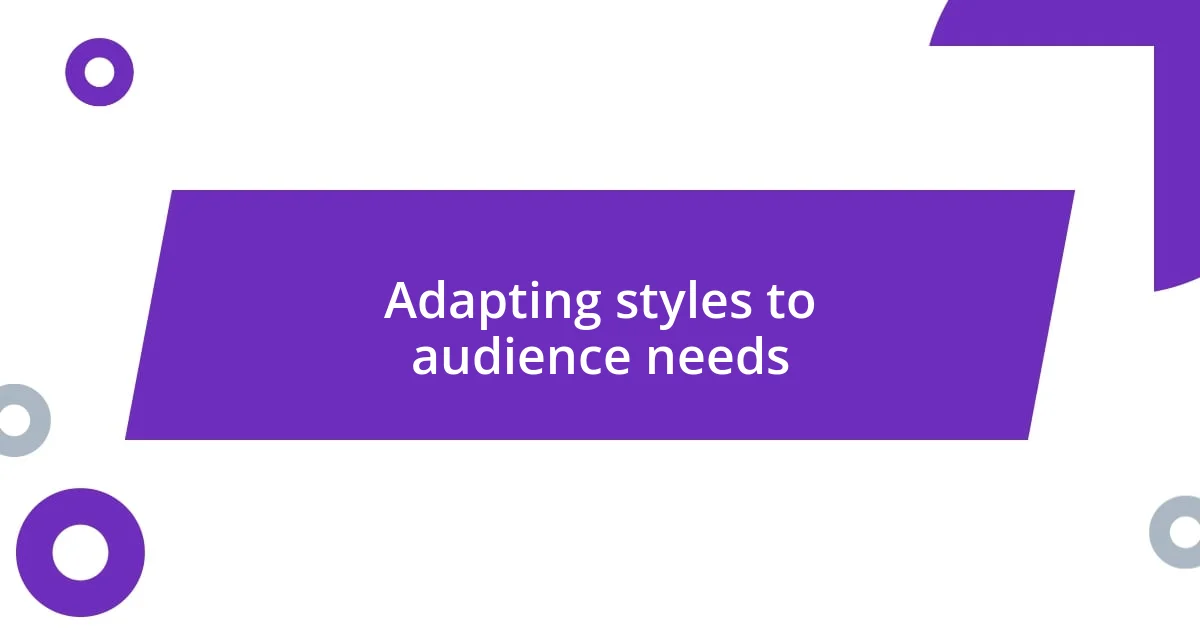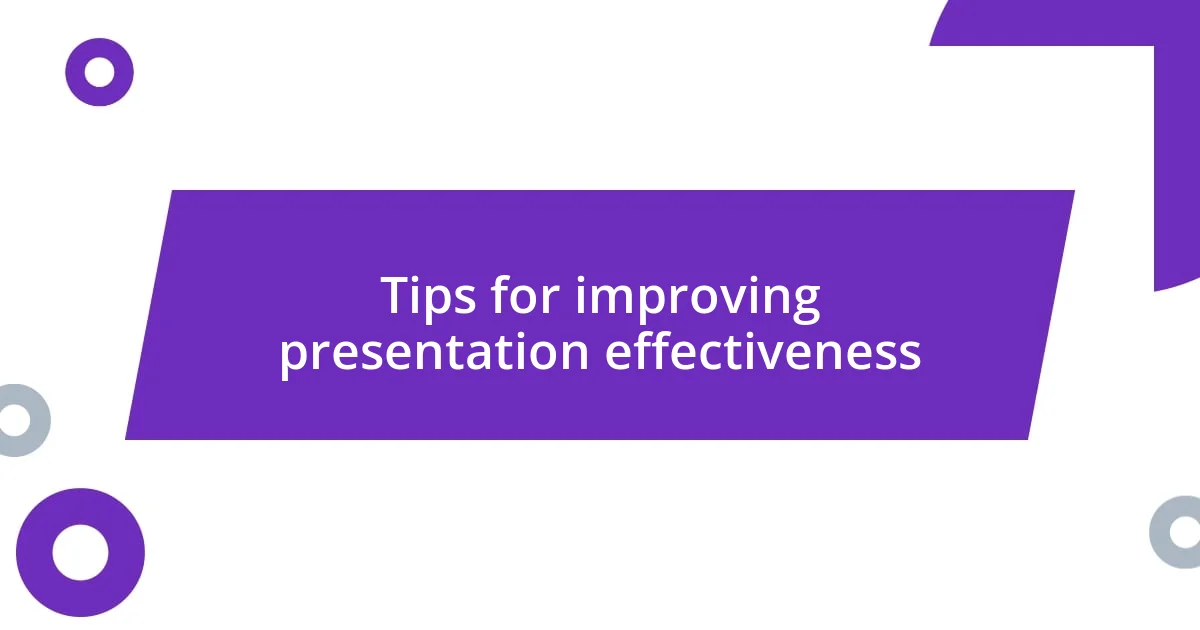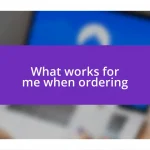Key takeaways:
- Different presentation styles, such as storytelling, demonstrative, and interactive approaches, significantly influence audience engagement and emotional connection.
- Effective presentations require adaptation to audience needs, incorporating elements like visuals, humor, and active listening to foster understanding and participation.
- The essence of impactful presentations lies in authenticity and connection, where presenters create memorable experiences rather than merely conveying information.

Understanding presentation styles
Understanding presentation styles is crucial for effective communication. I often find myself thinking about how different styles can evoke distinct emotions in the audience. For instance, when I used a storytelling approach during a presentation, I could see the listeners lean in, captivated by the narrative. It made me realize that a passionate delivery can be just as important as the content itself.
Have you ever noticed how some presenters rely heavily on visuals while others shine through their verbal skills? Personally, I’ve experienced both ends of the spectrum. When I focused more on text-heavy slides, I felt the energy in the room wane. In contrast, a friend of mine dynamically engaged the audience with minimal slides but an immersive discussion. It highlighted for me that understanding the right balance in presentation styles can significantly influence engagement.
Moreover, there’s something deeply personal about how we present ourselves. The tone, pace, and body language all factor into the style we choose. I recall feeling nervous as I fidgeted while presenting, and I could sense the distraction it caused. This taught me that self-awareness and confidence are key components of one’s presentation style. Have you ever caught yourself being more engrossed in a speaker’s energy rather than just their words? That’s the power of a well-executed presentation style.

Importance of effective presentations
Effective presentations play a pivotal role in conveying ideas and garnering audience interest. I’ve often seen how a compelling presentation can inspire action. For instance, during a recent team meeting, I opted for a more interactive style, encouraging questions throughout. By doing so, not only did the discussion feel more engaging, but it also fostered collaboration among team members, a feeling that solidified our connection.
- Captures and maintains audience attention
- Enhances understanding and retention of information
- Builds credibility and authority as a speaker
- Encourages audience interaction and feedback
- Facilitates clearer communication of ideas
- Promotes motivation and engagement with the content
Every time I emphasize the importance of practicing presentation techniques, I find this transforms the anxiety I sometimes feel into a sense of accomplishment. While preparing for one particular event, I practiced my material countless times, until I was almost comfortable enough to share it in my sleep. That preparation didn’t just solidify my knowledge; it also transformed my nervous energy into enthusiasm, something I could see resonated with the audience.

Different types of presentation styles
When it comes to presentation styles, I’ve encountered several distinct approaches that each create unique experiences. One style that stands out is the “demonstrative” approach. I remember the last time I used this method, showing a product in action while explaining its benefits. The audience’s eyes lit up, and I could feel their excitement building. It’s fascinating how visually showcasing a product can lead to real-time understanding and intrigue.
Conversely, the “lecture” style often emphasizes information delivery. I once attended a lengthy presentation where the speaker read from slides without much variation in tone. While the content was valuable, I found myself daydreaming, disconnected from the lecture. This experience taught me how critical it is to keep the audience engaged, and that monotony can easily stifle interest.
I gravitate towards a “call-and-response” style whenever I want to create an interactive environment. During a workshop, I asked participants to share their experiences related to the topic. The energy in the room shifted dramatically, and the shared stories created a sense of community. It’s this back-and-forth interaction that not only enlivens a presentation but also leaves a lasting impression on everyone involved.
| Presentation Style | Description |
|---|---|
| Demonstrative | Utilizes visuals or live demonstrations to explain concepts. |
| Lecture | Focuses on delivering information through verbal explanations, often with slides. |
| Call-and-Response | Encourages audience participation through questions and discussions. |

Personal reflections on presentation styles
One thing I’ve noticed as I reflect on various presentation styles is how much my delivery shifts based on the audience. For instance, during a community workshop, I adopted a storytelling approach, weaving personal anecdotes into the content. I could see people’s faces light up as they connected with the emotional wave of the story – it reminded me how shared experiences can dissolve barriers and create intimacy. Have you ever felt that powerful moment when a story resonates? It’s a reminder of how critical it is to choose a style that feels authentic to you.
Another aspect I find intriguing is the impact of visuals in presentations. I remember a time when I integrated infographics into my slides. The room was alive with buzz as participants engaged with the visuals, sparking discussions I hadn’t anticipated. This has led me to wonder: does the right visual format amplify comprehension? I’ve witnessed firsthand how thoughtful visuals can transform abstract ideas into relatable concepts, elevating the whole experience.
Lastly, I’ve always believed that humor has a remarkable place in presentations. During a corporate presentation, I shared a lighthearted personal mishap related to the topic. The room erupted in laughter, instantly breaking the ice and fostering a sense of camaraderie. It made me realize that a little levity not only lightens the mood but also makes the content more memorable. How often do we leave a presentation with more than just information? Those moments of laughter linger long after, enhancing retention and engagement.

Adapting styles to audience needs
When I tailor my presentation style to the audience’s needs, I always consider their background and expectations. For instance, during a corporate training session, I noticed many participants were new to the topic. I decided to simplify the language and incorporate real-world examples they could relate to. It was rewarding to see the spark of understanding in their eyes as they grasped concepts that previously felt out of reach.
Thinking about my experience in a classroom setting brings to mind the time I had a diverse group of learners. I chose to alternate between visual aids and group activities to maintain their interest. One particular moment stands out: a quiet student suddenly voiced his thoughts during a group discussion, adding a fresh perspective that energized the entire class. It made me realize just how crucial it is to create an environment where everyone feels empowered to share, adapting my style accordingly.
Moreover, the feedback I receive post-presentation often highlights how well I adapted to the audience. At a recent alumni event, several attendees mentioned they appreciated my personal stories woven throughout the discussion. It makes me wonder: are we sometimes too focused on delivery to realize the power of connection? I truly believe that when we engage our audience with tailored narratives, we create an atmosphere where the information sticks, resonating long after the session ends.

Tips for improving presentation effectiveness
To enhance presentation effectiveness, one important tip I’ve picked up is to practice active listening. I remember a time at a seminar when audience questions shifted my focus entirely. I had prepared a specific narrative, but listening to the attendees revealed their interests and concerns. By adapting my responses on the spot, I fostered a more engaging dialogue. Have you ever noticed how much more meaningful a presentation can feel when the audience feels heard?
Another effective approach is incorporating interactive elements, like polls or small group discussions. Last year, during a large conference, I decided to break my audience into smaller groups. When I did that, the energy in the room surged. The participants began to share their thoughts and build on each other’s ideas, creating an electric atmosphere that I hadn’t anticipated. This experience taught me that fostering interaction not only keeps the audience engaged but deepens their understanding of the topic. Can you recall a moment when you actively participated in a discussion and how it shifted your perspective?
Visual storytelling has also proven invaluable in my presentations. I once created a slide deck that highlighted a critical project through a series of compelling images rather than exhaustive text. The audience responded with a palpable interest, leaning forward, eager to hear more. This experience reinforced my belief that a well-placed image can evoke emotions and create memorable connections. Have you found that certain visuals bring your content to life in a way that words alone can’t?

Conclusion on presentation styles
Examining the various presentation styles has made me appreciate the nuances of communication deeply. I recall a time when I attended a panel discussion where each expert had a distinct style. One was very academic, while another invited the audience into their personal story. I found myself leaning forward for the latter because connecting through shared experiences felt more powerful than facts alone. Isn’t it fascinating how the right style can transform a mundane topic into something inspiring?
It’s clear to me that there’s no one-size-fits-all approach to presentations. I remember hosting a workshop where I tried an entirely different style, incorporating humor and relatable scenarios. The laughter that erupted was unexpected and refreshing. This shift not only warmed up the room but also made complex ideas feel more accessible. Have you ever experienced a moment in a presentation where humor turned the mood around?
In the end, presentation styles are not merely about conveying information; they’re about crafting an experience. Each time I present, I aim to create a connection, ensuring the audience walks away with a sense of ownership over the information shared. Looking back at my journey, I realize that what truly resonates is authenticity and connection. Isn’t that what we all seek in communication?












